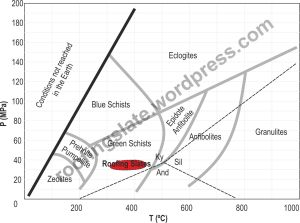Different types of roofing slates
02/25/2013 1 Comment
Definition of roofing slate after EN 12326
According to EN 12326-1:2005, from a commercial point of view, a roofing slate is a “rock which is easily split into thin sheets along a plane of cleavage resulting from a schistosity flux caused by very low or low grade metamorphism due to tectonic compression. It is distinguished from a sedimentary slate (shale, author´s note) which invariably splits along a bedding or sedimentation plane. Slate originates from clayey sedimentary rocks and belongs petrographically to a range which begins at the boundary between sedimentary and metamorphic formations and ends at the epizonal-metamorphic phyllite formations”.
This definition makes quite clear, from a petrological point of view, the range of rocks which can be considered slates. However, EN 12326-1:2005 continues defining roofing slate as a ”rock used for roofing and cladding, in which phyllosilicates are the predominant and most important components and exhibiting a prominent slaty cleavage”. Likewise, roofing carbonate slate is defined in the same way as above but with a minimum of 20% content of carbonate.
For the Subcomission on the Systematics of Metamorphic Rocks (SCMR), a part of the International Union of Geological Sciences (IUGS), a slate s.s. is “an ultrafine- or very fined-grained rock displaying slaty cleavage”. This slaty cleavage is also defined as “a type of continuos cleavage in which the individual grains are too small to be seen by the unaided eye”. The slaty cleavage is the most important characteristic of roofing slates, since it allows the rock to be split into large and thin tiles.
It is clear that there are two types of rocks, slates s.s., sometimes also called lutitic slates, which are low-grade metamorphic rocks (greenschist facies), and commercial slates or roofing slates, which are rocks composed mainly of phyllosilicates with an exfoliation which allows to produce tiles that may be used as roofing materials. This second group includes the slates s.s. together with other types of rocks, like shales, phyllites and schists.
A: Sedimentary slate (shale) with no develop of slaty cleavage. The planes correspond to sedimentation beds. Minas Gerais, Brazil.
B: Slate s.s., in which the planes correspond to slaty cleavage. Herbeumont, Belgium.
C: Phyllite, with a metamorphic grade slightly higher than the slate s.s., as the biotite crystals shows. Bernardos, Spain.
D: Schist, with a well developed schistosity. Finnmark, Norway.


Slate has been one of the most frequently used roofing materials, especially from years gone by. Sure, there are lighter and probably more effective ways to roof your home now, but slate is still a popular hardy waterproof material.